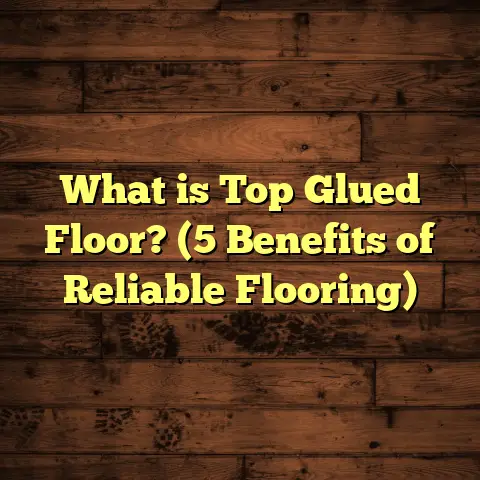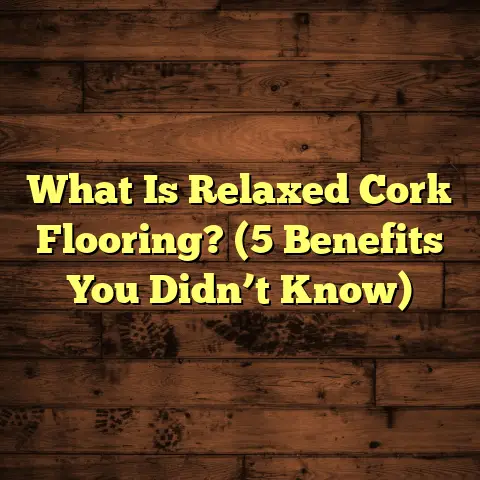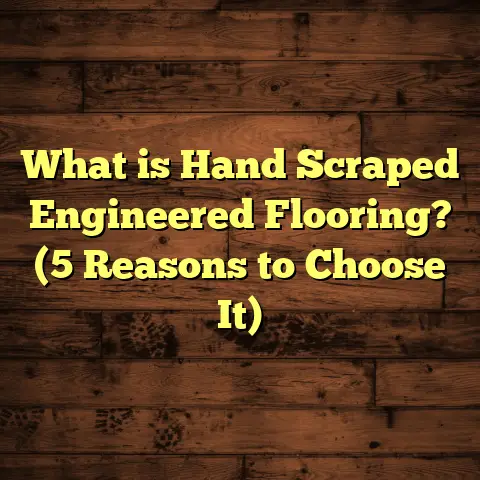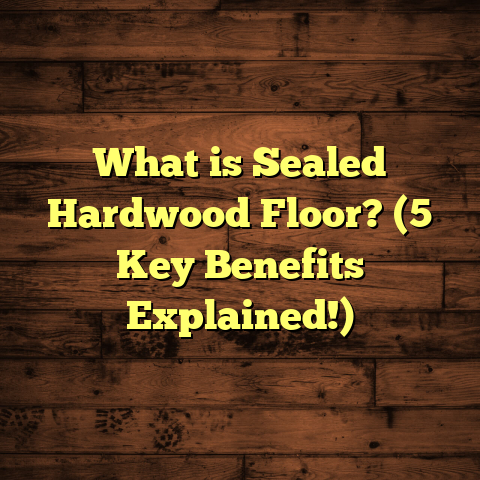What is Average Price for Buffing and Polishing Concrete? (5 Tips to Save Big!)
When I think about flooring in my home, my mind immediately goes to my family. After all, the floors are where my kids play, where we gather for movie nights, and where countless memories take shape. Having a floor that looks great and lasts long means a lot, especially when it comes to concrete surfaces. Buffing and polishing concrete floors can make a huge difference not just in appearance but in durability too. But what’s the average price for buffing and polishing concrete? And how can you save money without cutting corners? Let me walk you through everything I’ve learned from years of experience with concrete flooring projects.
What is Buffing and Polishing Concrete?
Buffing and polishing concrete is a process that transforms a plain, dull slab into a shiny, smooth surface. Think of it like giving your concrete floor a spa treatment. Buffing involves grinding down the surface to remove imperfections, while polishing uses finer abrasives to create a glossy finish.
The process usually starts with coarse grinding to level the floor and expose the aggregate (small stones inside the concrete). Then, progressively finer polishing pads smooth the surface until it shines. Sometimes, chemical sealers or densifiers are applied to harden the floor and protect it from stains.
I remember working on a client’s basement floor that was rough and stained. After buffing and polishing, it looked almost like marble — sleek, reflective, and easy to clean. The best part? It cost way less than installing new flooring.
Now, why would someone choose buffing and polishing over other flooring options? For starters, polished concrete is incredibly durable. It handles heavy foot traffic without scratching or staining easily. Plus, it’s low-maintenance — no need for waxing or special cleaners. Besides being practical, polished concrete floors reflect light, which can brighten up rooms and even help reduce energy costs by improving lighting efficiency.
The Science Behind Polishing Concrete
To get a bit technical (but not too much), polishing concrete involves removing microscopic layers of the surface with abrasive pads. This exposes the aggregate and compacts the surface, making it denser and less porous. When densifiers are added during polishing, they chemically react with the concrete to further harden it.
Because of this compaction and sealing effect, polished concrete resists dusting — the tiny particles that often appear on unfinished concrete floors. This dusting can be a real pain in homes with kids or pets since it spreads everywhere.
Breaking Down the Cost of Buffing and Polishing Concrete
Let’s get into the numbers because that’s what everyone really wants to know.
The average price for buffing and polishing concrete typically ranges from $3 to $8 per square foot. This range depends on several factors:
- Condition of the existing concrete: Floors with cracks or heavy stains may require extra preparation.
- Level of shine: A basic matte finish costs less than a high-gloss mirror polish.
- Size of the area: Larger projects often get better pricing per square foot.
- Location: Labor costs vary widely depending on your region.
- Additional treatments: Applying sealers or dyes adds to the price.
For instance, when I polished my own garage floor (about 400 square feet), I paid around $1,800 total — roughly $4.50 per square foot for a mid-level polish with a protective sealer. It was well worth it given how much easier it is to maintain now.
What Makes Up the Cost?
Breaking down that $3 to $8 per square foot gives you a better idea of where your money is going:
| Cost Component | Typical Range (%) | Notes |
|---|---|---|
| Labor | 40% – 60% | Grinding and polishing takes skill |
| Materials | 20% – 30% | Pads, sealers, densifiers |
| Surface Preparation | 10% – 20% | Cleaning, repairing cracks |
| Equipment Rental | 5% – 10% | Machines for grinding/polishing |
| Waste & Contingencies | 5% | Extra materials or unforeseen issues |
This table is based on my experience working on various projects and talking with contractors. Labor tends to be the biggest chunk because polishing requires specialized equipment and expertise.
Case Study: Residential Living Room Polish
A couple in my neighborhood wanted their 600-square-foot living room concrete floor polished to a high gloss. After assessing their floor, I estimated $6 per square foot due to some minor patchwork needed beforehand. The total cost was $3,600.
They reported back that the polished floor made their space look bigger and brighter, plus their kids loved playing there without worrying about splinters or rough spots.
I also learned that when floors are in really bad shape, cost shoots up quickly. For example, removing old coatings or paint before polishing can add hundreds or thousands of dollars.
Personal Stories: My Journey With Concrete Polishing
I’ve polished several floors myself and worked with contractors on even more projects for friends and clients. One story that sticks out was a community center gym floor I helped restore. The original concrete was chipped and dull after years of use.
We spent almost a week grinding down old finishes and patching cracks. The polishing stage took two days with multiple passes using different grit pads. The final result was stunning — light bounced off the floor in such a way that it felt like a brand-new space.
The center director told me they saved so much on cleaning because dust no longer gathered on the floor. Plus, kids were safer running around thanks to the smooth surface that still offered enough traction.
Five Tips to Save Big on Buffing and Polishing Concrete
Saving money while still getting great results requires some planning and insider knowledge. Here are five tips I always share:
1. Prepare Your Concrete Floor Yourself
Before hiring pros, do some prep work like cleaning thoroughly and fixing small cracks or holes. Removing dirt, grease, or adhesive residues can reduce grinding time and labor costs. I spent an afternoon scrubbing my basement floor before polishing — it saved me about 15% on the quote.
Cleaning is critical because dust, oil spots, or paint residues can prevent the polish from bonding properly. I recommend using a degreaser for oily spots and a stiff brush to remove dirt.
2. Compare Multiple Quotes
Don’t settle for the first estimate you get. Pricing can differ by hundreds or even thousands of dollars depending on contractors’ experience and equipment. I usually get at least three quotes before committing. Ask about their process and what’s included so you don’t get hit with surprise fees later.
When you get these quotes, ask if they include:
- Surface preparation cost
- Number of polishing passes
- Type of sealers used
- Cleanup afterward
Sometimes cheaper quotes leave out important steps that result in poor finish or shorter lifespan.
3. Choose the Right Level of Polish
Decide if you want a high-gloss mirror finish or something more subtle like satin or matte. Higher gloss takes more time and consumables, which drives up cost. For busy family areas, I recommend a satin finish — it hides scratches better and still looks sharp.
Here’s how I explain polish levels to friends:
| Finish Type | Appearance | Maintenance | Cost Range (per sq ft) |
|---|---|---|---|
| Matte | Low shine, natural look | Easiest | $3 – $4 |
| Satin | Moderate shine | Moderate | $4 – $6 |
| High Gloss | Mirror-like shine | Requires care | $6 – $8+ |
4. Bundle Services
If you need other work done like crack repairs or applying stains/dyes, ask if the contractor offers package deals. Bundling can lower overall expenses compared to hiring separate specialists.
Once I did this for a client who wanted both crack repair and polishing along with a colored stain overlay. The combined quote was about 15% less than separate bids for each service.
5. Use Tools Like FloorTally for Budgeting
Here’s where my secret weapon comes in: FloorTally. This tool has helped me estimate costs quickly using local labor and material rates. It saves me from juggling multiple spreadsheets or calls for pricing.
FloorTally lets me input project dimensions, choose polish levels, add waste factors, and even factor in labor costs based on my area. Using it gives me confidence in budgeting and negotiating prices with contractors because I have data-backed figures at my fingertips.
When I was planning my basement polish project last year, using FloorTally saved me hours of research time while helping me avoid overestimating my budget by about 10%.
How Long Does Buffing and Polishing Concrete Last?
From what I’ve seen personally and through customer feedback, polished concrete floors usually last 10 to 20 years with proper care. That’s a great return on investment compared to other flooring types that might need replacement or refinishing more often.
Regular cleaning with neutral pH cleaners and avoiding harsh chemicals keeps the shine intact longer. If areas show dullness over time, quick touch-ups with buffing pads can restore appearance without full re-polishing.
I once had a client ask me if they needed to re-polish every few years — not necessarily if you maintain well! A good sealer applied during polishing protects against stains and wear.
Pros & Cons of Buffed and Polished Concrete
When recommending this option to friends or clients, I always weigh pros and cons out loud:
Pros
- Very durable & long-lasting
- Low maintenance & easy cleaning
- Reflects light & brightens rooms
- Eco-friendly (uses existing slab)
- Resists stains & dusting
Cons
- Initial cost can be high depending on condition
- Surface can be slippery if not treated properly
- Repairing deep cracks later can be tricky
- Concrete temperature can be cold underfoot (though rugs help!)
I remember one friend was worried about slipperiness since she has toddlers crawling around. We chose a satin finish with anti-slip additives in sealer — perfect balance.
What Affects Pricing Most?
From my experience talking with contractors and clients, these factors impact price the most:
| Factor | Impact on Price |
|---|---|
| Floor Condition | More damage or staining = higher cost |
| Desired Finish | High gloss > satin > matte |
| Area Size | Larger area = lower cost per sq ft |
| Regional Labor Rates | Urban areas tend to be pricier |
| Additional Treatments | Sealers, dyes add $0.50-$2 per sq ft |
Knowing this can help you focus your budget wisely.
For example, in rural areas where labor rates are lower, I’ve seen prices closer to $3 per sq ft for basic polishing. Meanwhile in big cities like New York or Chicago, prices tend toward $7-$8 per sq ft due to higher labor costs.
Comparing Polished Concrete Cost to Alternatives
It helps me (and hopefully you) when planning budgets to compare polished concrete prices with other popular flooring types:
| Flooring Type | Average Cost (per sq ft) | Durability | Maintenance |
|---|---|---|---|
| Polished Concrete | $3 – $8 | Very High | Low |
| Hardwood | $6 – $12 | High | Moderate |
| Laminate | $2 – $6 | Moderate | Moderate |
| Carpet | $2 – $5 | Low-Moderate | High (stains/dust) |
| Tile | $5 – $15 | High | Moderate |
Polished concrete offers great value if you want durability plus low upkeep for busy households like mine.
Maintenance Tips Based on My Experience
Maintaining polished concrete is pretty straightforward but pays off big time:
- Sweep or vacuum regularly to avoid grit scratching surface.
- Mop with neutral pH cleaner weekly or biweekly.
- Avoid acidic cleaners like vinegar or bleach — they can etch surface.
- Place mats at entryways to trap dirt.
- Clean spills quickly before they stain.
- Reapply sealer every few years depending on wear level.
- Use felt pads under furniture legs to prevent scratches.
I follow these tips at home and haven’t had any dull spots even after several years.
Environmental Benefits of Polished Concrete Floors
One aspect often overlooked is how polished concrete floors are environmentally friendly:
- Uses existing slab — no new raw materials needed.
- Reduces need for carpet/tile disposal.
- Reflects light — lowers electricity use for lighting.
- Durable — less frequent replacements mean less waste.
My friend who runs an eco-conscious business chose polished concrete partly for these reasons. She said it fits her values while looking professional.
How Do Contractors Price Their Work?
After chatting with several contractors over time, here’s what I learned about their pricing methods:
- Assessment first: They inspect floor condition including cracks, coatings.
- Surface prep estimate: Time spent cleaning/repairing is figured out.
- Number of polishing passes: More passes mean higher labor/material costs.
- Sealer & densifier application: Different products have different prices.
- Square footage calculation: Base price multiplied by area size.
- Additional work: Crack filling, staining priced separately.
- Travel & disposal fees: Sometimes added depending on location/project size.
Knowing this helps me negotiate better by understanding what each part costs rather than just accepting lump sums.
Frequently Asked Questions From My Clients
Here are common questions people ask me about buffing and polishing concrete along with answers based on experience:
Q: Can buffed concrete be slippery?
A: It can be if polished to high gloss without anti-slip treatment. Adding texture or anti-slip additives helps prevent accidents — especially important if you have kids or seniors at home.
Q: How long does polishing take?
A: For an average room (~500 sq ft), expect 2-4 days including prep time depending on condition.
Q: Is polished concrete cold?
A: Yes, concrete tends to feel cold underfoot but area rugs help add warmth and comfort in family spaces.
Q: Can I do it myself?
A: DIY kits exist but professional equipment produces better results faster; plus contractors have skills for repairs/prep you might miss.
Q: Does polishing hide cracks?
A: No — cracks need repair before polishing; otherwise they remain visible.
Final Thoughts On Cost vs Value
Buffing and polishing concrete isn’t just about making floors look nice — it’s a smart investment in durability and ease of maintenance. While upfront costs vary ($3–$8+ per square foot), the long-term benefits often outweigh spending on carpet replacements or tile repairs.
Using tools like FloorTally makes budgeting easier so you don’t overspend or underestimate your project needs. Plus, following simple tips like prepping floors yourself or choosing finishes carefully can save you hundreds.
If you’re thinking about polishing your concrete floors for your family’s comfort and style, remember it’s not just a project — it’s creating a lasting foundation for your home memories.
If you want me to help you calculate an estimate for your specific space using FloorTally or share more personal anecdotes about flooring projects, just ask!





